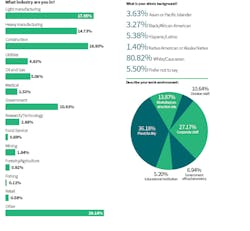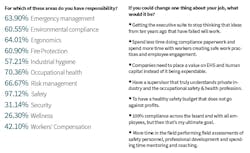Challenges in the safety industry are abundant, and EHS professionals have to adapt to remain in compliance and reduce injury risk. In EHS Today's 2018 National Safety Survey, 870 safety leaders commented on the biggest obstacles facing the industry today, and what they're doing to overcome them.
While 80% of survey respondents indicated that top management supports safety efforts, many respondents believe executives don't fully understand the value of keeping workers safe. Here are the challenges they said arise when it comes to executives understanding safety culture:
• "For EHS professionals, the lack of emotional intelligence (EQ) skills and the disconnect of EHS value integrating/supporting business goals."
• "Adequate training [is needed]. Too many companies pile employees into a room full of computers, where they fly through safety training. The supervisor just sits and reads the paper."
• "Doctors are prescribing drugs to employees after a workplace incident when not needed, which then requires documentation on the OSHA log. This makes your safety program look much worse than it really should, which in turn requires you to try to explain why there are so many OSHA recordables to management. Then management ends up making kneejerk decisions to drive down the number of minor injuries vs focusing on the risk for the more severe ones that haven't happened yet."
• "Too much influence is wielded by people who only care about next quarter's numbers. Employees are an expendable supply."
• "Our corporate culture assumes one-size-fits-all when it comes to worker safety and facility safety requirements. Different facilities are at different places in their safety journey so you can apply the same logic to all."
• "I work for a large global corporation. The biggest frustration is the development of 'global' standards by people who do not have interaction with the plants and try to do the one-size-fits-all approach. They don't look at the sites and allow them to do what makes sense for the specific situation at the individual sites."
Data could be the key to proving how effective a robust safety program could be to a company's culture and bottom line. EHS professionals increasingly are using technology to identify and reduce workplace hazards through recording and using data, according to survey results. About 58% of respondents said they are using software to track, manage, analyze and report data about their facility's safety performance.
We also asked survey respondents how they plan to use safety data within their operations:
" We are going through a mobile data initiative, so field inspections, PPE needs and good catch/close call cards are all being tracked and managed real time as they are entered and stored in databases. This also allows us to share with other companies in hopes of preventing similar incidents elsewhere."
" Expand the data mining to begin tracking leading indicators and determine key programs on which to focus messaging and informational empowerment efforts."
" To provide the information to educate our employees on how well they are doing with our company safety polices. They need to hear some praise from someone."
" Identify problem areas and opportunities for improvement. Also to identify areas where action items are not being closed and where we need to focus more of our efforts and time."
" It's easier to track and, with a click of a button, send out to all of management and allow them to observe what I have found. Without them knowing all details and evidence to back it up, things can't get resolved."
" The data collected from the software will be visible to management and give them more of an understanding of the necessity of the safety program and hopefully gain more support."
Despite having to prove the value of safety to top management, survey respondents indicate overall satisfaction with their roles, with 85% saying they were either 'very satisfied' or 'satisfied' with their choice. Here is what survey takers had to say about their careers:
" I love my job. It affords me the ability to use most of my skills and gifts."
" After 21 years and retiring from my previous employer as a safety professional, I have seen the ups and downs with the safety profession. It has been a challenging career, yet rewarding. Now I am a safety professional for a government entity carrying the safety torch. I enjoy seeing our profession expand with new ideas and technology that help us keep our employees safe."
" I am very fortunate to have senior management support for our growing safety program. We had only one recordable injury in 2017 and zero in 2018. It's been almost 27 years since we had a lost time accident, which is rare in manufacturing! That is due to the commitment from all levels of management."
" I love EHS, although it isn't for the faint of heart. Energy, passion and vision are characteristics that elude many EHS professionals and are absolutely necessary for the success of industry and culture."
Safety Industry Challenges
• "Small companies need to understand there is more to safety than just having a safety professional on board. It takes an honest commitment from executives to be positively involved in company safety and to involve safety in everything from the bidding process to project completion. Safety shouldn't start at the signing of the contract."
• "The biggest challenge is the do-as-I-say-not-as-I-do attitude from the general contractors I've worked with. They say they are all about safety and then let their own workers get away with and do whatever they want to do. It's a frustrating thing to be in a 10-story building with only one stairwell that is operational, and no matter how many times I've tried to fix it, the GC says that it won't be long, yet it's been two months."
• "Besides expecting to do more with less, lack of leadership accountability for production leadership. My staff and I are held accountable for accidents/injuries as to why accidents continue to occur, repetitive types of injuries continue to occur, and why work areas with high injury rates are not decreasing."
• "EHS responsibilities are being fanned out to folks who have many responsibilities, and the focus on safety gets lost. This is particularly true for small sites/offices, of which there can be many in a large corporation. It is often the small sites that have the worst practices for chemical storage, labeling, electrical power loading, fire protection, facility infrastructure (even floor loading!)."
• "More integration and collaboration between the environmental, safety, accessibility and industrial health fields would benefit the industry as a whole. In many companies, and especially in the federal government, these fields are still separate or are not working together effectively. Lapses of protection, lack of comprehensive workforce support and knowledge transfer occur when these fields are not functioning as an integrated partnership. Duplication of inspection and compliance reviews also occur when these fields are not collaborating. More acceptance and inclusion of environmental and accessibility professionals in our industry is one solution to this challenge."




